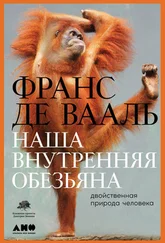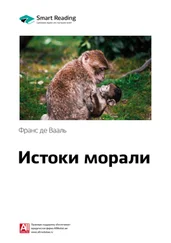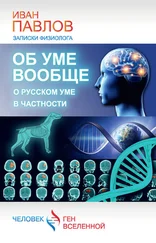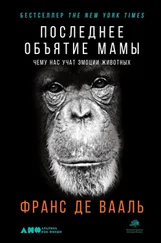McGrew, W. C. 2010. Chimpanzee technology. Science 328:579–80.
–. 2013. Is primate tool use special? Chimpanzee and New Caledonian crow compared. Philosophical Transactions of the Royal Society B 368:20120422. McGrew, W. C., and C. E. G. Tutin. 1978. Evidence for a social custom in wild chimpanzees? Man 13:243–51.
Melis, A. P., B. Hare, and M. Tomasello. 2006a. Chimpanzees recruit the best collaborators. Science 311:1297–300.
–. 2006b. Engineering cooperation in chimpanzees: Tolerance constraints on cooperation. Animal Behaviour 72:275–86.
Mendes, N., D. Hanus, and J. Call. 2007. Raising the level: Orangutans use water as a tool. Biology Letters 3:453–55.
Mendres, K. A., and F. B. M. de Waal. 2000. Capuchins do cooperate: The advantage of an intuitive task. Animal Behaviour 60: 523–29.
Menzel, E. W. 1972. Spontaneous invention of ladders in a group of young chimpanzees. Folia primatologica 17:87–106.
–. 1974. A group of young chimpanzees in a one-acre field. In Behavior of Non-Human Primates , ed. A. M. Schrier and F. Stollnitz, 5:83–153. New York: Academic Press.
Mercader, J., et al. 2007. 4,300-year-old chimpanzee sites and the origins of percussive stone technology. Proceedings of the National Academy of Sciences USA 104:3043–48.
Miklósi, Á., et al. 2003. A simple reason for a big difference: Wolves do not look back at humans, but dogs do. Current Biology 13:763–66.
Mischel, W., and E. B. Ebbesen. 1970. Attention in delay of gratification. Journal of Personality and Social Psychology 16:329–37.
Mischel, W., E. B. Ebbesen, and A. R. Zeiss. 1972. Cognitive and attentional mechanisms in delay of gratification. Journal of Personality and Social Psychology 21:204–18.
Moore, B. R. 1973. The role of directed pavlovian responding in simple instrumental learning in the pigeon. In Constraints on Learning, ed. R. A. Hinde and J. S. Hinde, 159–87. London: Academic Press.
–. 1992. Avian movement imitation and a new form of mimicry: Tracing the evoluting of a complex form of learning. Behaviour 122:231–63.
–. 2004. The evolution of learning. Biological Review 79:301–35.
Moore, B. R., and S. Stuttard. 1979. Dr. Guthrie and Felis domesticus or: Tripping over the cat. Science 205:1031–33.
Morell, V. 2013. Animal Wise: The Thoughts and Emotions of Our Fellow Creatures. New York: Crown.
Morgan, C. L. 1894. An Introduction to Comparative Psychology . London: Scott.
–. 1903. An Introduction to Comparative Psychology , new ed. London: Scott. Morris, D. 2010. Retrospective: Beginnings. In Tinbergen's Legacy in Behaviour : Sixty Years of Landmark Stickleback Papers , ed. F. Von Hippel, 49–53. Leiden, Netherlands: Brill.
Morris, R., and D. Morris. 1966. Men and Apes. New York: McGraw-Hill. Mulcahy, N. J., and J. Call. 2006. Apes save tools for future use. Science 312:1038–40.
Nagasawa, M., et al. 2015. Oxytocin-gaze positive loop and the co-evolution of human-dog bonds. Science 348:333–36.
Nagel, T. 1974. What is it like to be a bat? Philosophical Review 83:435–50.
Nakamura, M., W. C. McGrew, L. F. Marchant, and T. Nishida. 2000. Social scratch: Another custom in wild chimpanzees? Primates 41:237–48.
Neisser, U. 1967. Cognitive Psychology. Englewood Cliffs, NJ: Prentice-Hall.
Nielsen, R., et al. 2005. A scan for positively selected genes in the genomes of humans and chimpanzees. Plos Biology 3:976–85.
Nishida, T. 1983. Alpha status and agonistic alliances in wild chimpanzees. Primates 24:318–36.
Nishida, T., et al. 1992. Meat-sharing as a coalition strategy by an alpha male chimpanzee? In Topics of Primatology , ed. T. Nishida, 159–74. Tokyo: Tokyo Press.
Nishida, T., and K. Hosaka. 1996. Coalition strategies among adult male chimpanzees of the Mahale Mountains, Tanzania. In Great Ape Societies ed. W. C. McGrew, L. F. Marchant, and T. Nishida, 114–34. Cambridge: Cambridge University Press.
O'Connell, C. 2015. Elephant Don: The Politics of a Pachyderm Posse. Chicago: University of Chicago Press.
Ostoji´c, L., R. C. Shaw, L. G. Cheke, and N. S. Clayton. 2013. Evidence suggesting that desire-state attribution may govern food sharing in Eurasian jays. Proceedings of the National Academy of Sciences USA 110: 4123–28.
Osvath, M. 2009. Spontaneous planning for stone throwing by a male chimpanzee. Current Biology 19: R191–92.
Osvath, M., and G. Martin-Ordas. 2014. The future of future-oriented cognition in non-humans: Theory and the empirical case of the great apes. Philosophical Transactions of the Royal Society B 369:20130486.
Osvath, M., and H. Osvath. 2008. Chimpanzee ( Pan troglodytes ) and orangutan ( Pongo abelii ) forethought: Self-control and pre-experience in the face of future tool use. Animal Cognition 11:661–74.
Ottoni, E. B., and M. Mannu. 2001. Semifree-ranging tufted capuchins ( Cebus apella ) spontaneously use tools to crack open nuts. International Journal of Primatology 22:347–58.
Overduin-de Vries, A. M., B. M. Spruijt, and E. H. M. Sterck. 2013. Long-tailed macaques ( Macaca fascicularis ) understand what conspecifics can see in a competitive situation. Animal Cognition 17:77–84.
Parr, L., and F. B. M. de Waal. 1999. Visual kin recognition in chimpanzees. Nature 399:647–48.
Parvizi, J. 2009. Corticocentric myopia: Old bias in new cognitive sciences. Trends in Cognitive Sciences 13:354–59.
Paxton, R., et al. 2010. Rhesus monkeys rapidly learn to select dominant individuals in videos of artificial social interactions between unfamiliar conspecifics. Journal of Comparative Psychology 124:395–401.
Pearce, J. M. 2008. Animal Learning and Cognition: An Introduction , 3rd ed. East Sussex, UK: Psychology Press.
Penn, D. C., and D. J. Povinelli. 2007. On the lack of evidence that non-human animals possess anything remotely resembling a "theory of mind." Philosophical Transactions of the Royal Society B 362:731–44.
Pepperberg, I. M. 1999. The Alex Studies: Cognitive and Communicative Abilities of Grey Parrots. Cambridge, MA: Harvard University Press.
–. 2008. Alex and Me. New York: Collins.
–. 2012. Further evidence for addition and numerical competence by a grey parrot ( Psittacus erithacus ). Animal Cognition 15:711–17.
Perdue, B. M., R. J. Snyder, Z. Zhihe, M. J. Marr, and T. L. Maple. 2011. Sex differences in spatial ability: A test of the range size hypothesis in the order Carnivora. Biology Letters 7:380–83.
Perry, S. 2008. Manipulative Monkeys: The Capuchins of Lomas Barbudal. Cambridge, MA: Harvard University Press.
–. 2009. Conformism in the food processing techniques of white-faced capuchin monkeys ( Cebus capucinus ). Animal Cognition 12:705–16.
Perry, S., H. Clark Barrett, and J. H. Manson. 2004. White-faced capuchin monkeys show triadic awareness in their choice of allies. Animal Behaviour 67:165–70.
Pfenning, A. R., et al. 2014. Convergent transcriptional specializations in the brains of humans and song-learning birds. Science 346:1256846.
Pfungst, O. 1911. Clever Hans (The Horse of Mr. von Osten): A Contribution to Experimental Animal and Human Psychology . New York: Henry Holt.
Plotnik, J. M., et al. 2014. Thinking with their trunks: Elephants use smell but not sound to locate food and exclude nonrewarding alternatives. Animal Behaviour 88:91–98.
Читать дальше
Конец ознакомительного отрывка
Купить книгу
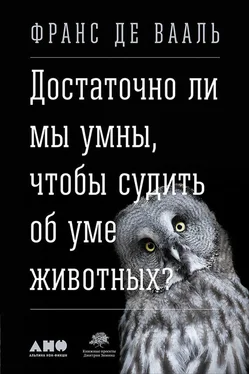
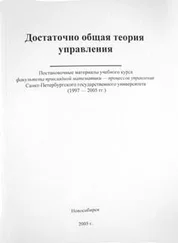
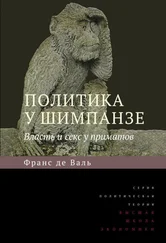


![Франс Вааль - Последнее объятие Мамы [litres]](/books/406055/frans-vaal-poslednee-obyatie-mamy-litres-thumb.webp)

